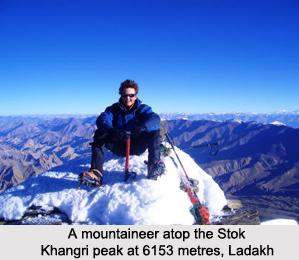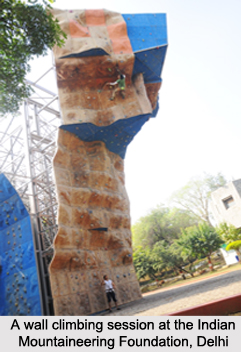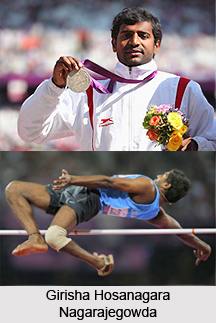 Mountaineering in India is a challenging popular concept; given the country"s entire north and north-eastern borders is the highest mountain range in the world, the mighty Himalayas. The Indian Himalaya covers the country"s north and north-east parts of Jammu and Kashmir, Himachal Pradesh, Uttarakhand, Sikkim and Arunachal Pradesh. Along with the majestic Himalayas, India is also bounded by the eastern section of the Karakoram mountain range. These ranges have triggered the challenge and popularity of the sport of mountaineering and climbing in India, in the enthusiasts who thrive scaling the peaks and elevating their reach level with every peak accomplished. The Kanchenjunga in India ranges beyond 8000 metres. Few peaks between ranges 7000 to 8000 metres are still untouched. A large number of those ranging between 6000 to 7000 metres are virgin. There is no questioning mountaineering and mountaineers in India, are left with immense scope for exploration and conquest. The apex body for mountaineering in India is the Indian Mountaineering Foundation (IMF), established in 1957 to organise, support and provide a base for expeditions for mountaineering, skiing, rock climbing and trekking at high altitudes. It is affiliated to the International Federation of Sport Climbing.
Mountaineering in India is a challenging popular concept; given the country"s entire north and north-eastern borders is the highest mountain range in the world, the mighty Himalayas. The Indian Himalaya covers the country"s north and north-east parts of Jammu and Kashmir, Himachal Pradesh, Uttarakhand, Sikkim and Arunachal Pradesh. Along with the majestic Himalayas, India is also bounded by the eastern section of the Karakoram mountain range. These ranges have triggered the challenge and popularity of the sport of mountaineering and climbing in India, in the enthusiasts who thrive scaling the peaks and elevating their reach level with every peak accomplished. The Kanchenjunga in India ranges beyond 8000 metres. Few peaks between ranges 7000 to 8000 metres are still untouched. A large number of those ranging between 6000 to 7000 metres are virgin. There is no questioning mountaineering and mountaineers in India, are left with immense scope for exploration and conquest. The apex body for mountaineering in India is the Indian Mountaineering Foundation (IMF), established in 1957 to organise, support and provide a base for expeditions for mountaineering, skiing, rock climbing and trekking at high altitudes. It is affiliated to the International Federation of Sport Climbing.
Mountaineering Institutes in India
The premier institutes in India for mountaineering are:
•Himalayan Mountaineering Institute (HMI), Darjeeling
•Nehru Institute of Mountaineering (NIM), Uttarkashi
•Indian Institute of Skiing and Mountaineering (IIS&M), Gulmarg
•Jawahar Institute of Mountaineering, Pahalgam
•Atal Bihari Vajpayee Institute of Mountaineering and Allied Sports, Manali
The Himalayan Mountaineering Institute was the first institute established in India, to encourage mountaineering as an organised sport, with the impetus from the then Prime Minister Jawaharlal Nehru. The first field director at HMI was Tenzing Norgay, one of the two very first individuals to reach the summit of Everest along with Edmund Hillary. Their ascent to the highest mountain peak in the world sparked a keen interest in establishing mountaineering as a well revered endeavour. Adventure, Basic and Advanced Mountaineering comprehensive courses are regularly conducted at HMI, and are well subsidised to encourage the sport.
Himalayan Mountaineering
The mysteriously humongous Himalayan Mountains have allured all; the sages in look for the Heavenly, the writers in search of truth, ordinary men and women in pursuit of their gods and goddesses, athletes pushing the envelopes of human endurance, men of science in search of wondrous herbs and plants, all have been truly captivated by the enchanted Himalayas and its unlocked mysteries.
 The Indian Himalayas is a paradisiacal avenue for mountaineers and mountain expeditions, for the purpose of which, it is categorised into five broad heads of mountain ranges. These include the Arunachal Himalaya (also known as the Assam Himalaya), the Sikkim Himalaya bordering China and Nepal, the Uttarakhand Himalaya (Garhwal and Kumaon areas), the Himachal Himalaya (Kullu, Kinnaur, Lahaul and Spiti valleys) and finally the Jammu & Kashmir Himalaya, with peaks at Kashmir, Zanskar, Kishtwar and Ladakh districts. All these Himalayan regions are stunningly eye-catchy and have their own aspects of flora and fauna, culture, climate and terrain. They all have innumerable mountain peaks ranging from 5,000 metres to more than 8,500 metres of altitude, and their own historic archives of ascents and reaching atop the pinnacles. The Nanda Devi peak of the Nanda Devi Sanctuary in the heart of Garhwal, is the most beautiful peak of the Indian Himalayas, elevating up to 7,816 metres. And of course the mighty Kanchenjunga, the world"s third highest mountain peak at 8,586 metres, is in northern Sikkim, partly connecting with Nepal. The Nanda Devi and the Kanchenjunga are the two highest mountain peaks in India. The Himalayan mountain peaks are tempting, with an open invitation to enthusiastic climbers.
The Indian Himalayas is a paradisiacal avenue for mountaineers and mountain expeditions, for the purpose of which, it is categorised into five broad heads of mountain ranges. These include the Arunachal Himalaya (also known as the Assam Himalaya), the Sikkim Himalaya bordering China and Nepal, the Uttarakhand Himalaya (Garhwal and Kumaon areas), the Himachal Himalaya (Kullu, Kinnaur, Lahaul and Spiti valleys) and finally the Jammu & Kashmir Himalaya, with peaks at Kashmir, Zanskar, Kishtwar and Ladakh districts. All these Himalayan regions are stunningly eye-catchy and have their own aspects of flora and fauna, culture, climate and terrain. They all have innumerable mountain peaks ranging from 5,000 metres to more than 8,500 metres of altitude, and their own historic archives of ascents and reaching atop the pinnacles. The Nanda Devi peak of the Nanda Devi Sanctuary in the heart of Garhwal, is the most beautiful peak of the Indian Himalayas, elevating up to 7,816 metres. And of course the mighty Kanchenjunga, the world"s third highest mountain peak at 8,586 metres, is in northern Sikkim, partly connecting with Nepal. The Nanda Devi and the Kanchenjunga are the two highest mountain peaks in India. The Himalayan mountain peaks are tempting, with an open invitation to enthusiastic climbers.
Eastern Karakoram Mountaineering
The valleys in the extreme north of India are those of the Eastern Karakoram, which forms a special group in the great Karakoram Range, the second highest mountain range in the world. It encompasses some very high mountains, many of them still unclimbed and some scaled only in recent years.
The highest virgin peaks in Eastern Karakoram are the Saltoro Kangri II (south of Saltoro Kangri) at 7,705 metres, the Saser Kangri II East at 7,518 metres, the Saser Kangri III North at 7,495 metres and the Pk 7410 of Teram Kangri Group at 7,410 metres.
The Eastern Karakoram peaks are open to joint ventures between Indian and foreign mountaineers. Permits for climbing are readily available for almost all peaks.
The Indian Mountaineering Foundation organises CLIMBATHON annually, for qualified and experienced mountaineers, to develop and with practice master alpine climbing skills on rock, snow and ice surfaces. This expedition programme addresses the issues and concerns that rise from the previous year"s experience. Leading to participation is an expedition where all the skills developed are employed in mountain setting. The Climbathon 2015 was organised as an Alpine Mountaineering Leadership Programme with the core focus to build leadership and team building skills centred around mountaineering, in the Bara Shigri Glacier in the Himachal Himalaya. The participants were trained on route finding, managing hazards, assessing terrain features, self-rescue so that by the course"s end they had developed the ability to lead a small team safely through a rugged and complex environment. This was tested in the lead ascent of a challenging peak around the glacier.
Some notable Indian mountaineers include Krushnaa Patil, Asim Mukhopadhyay, Mohan Singh Kohli, Mandip Singh Soin and Colonel Narendra Kumar.



















